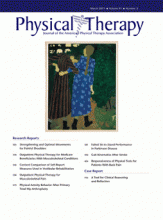We thank Ludewig for her complementary and thought-provoking commentary1 on our article.2 We hope that this discussion will facilitate translation of the Strengthening and Optimal Movements for Painful Shoulders (STOMPS) study results into clinical practice.
The first topic of discussion in Ludewig's commentary was our choice of statistical tests. One of our aims was to identify the impact of the intervention on outcomes at all levels of the International Classification of Functioning, Disability and Health (ICF) model, including body functions and structures, activity, and participation. We designed our statistical analysis plan to address this aim while minimizing the risk of type I error from a large number of statistical comparisons. The primary analysis required a between-groups comparison of response to the intervention. We elected to test the interaction between time and intervention group for the outcome variables because it includes the influence of the baseline values and we felt it was a superior analysis to comparison of outcomes at the postintervention assessment.3 Testing the interaction between time and intervention group is both conceptually and mathematically analogous to a between-group comparison of the change score with the baseline score as a covariate in our 2 × 2 design. We also conducted a secondary post hoc analysis of the preintervention to postintervention change within groups to demonstrate when the difference in change scores identified by a significant interaction actually signified a positive improvement in the intervention group. A direct assessment of the magnitude of the between-group treatment effects also is reflected in the effect sizes of the interaction test that were included in the article. Guerorguieva and Krystal3 provided an informative discussion of the merits and limitations of end-point analysis, repeated-measures analysis of variance, and mixed-effects models, which we used for the intention-to-treat analysis in the STOMPS trial. …












